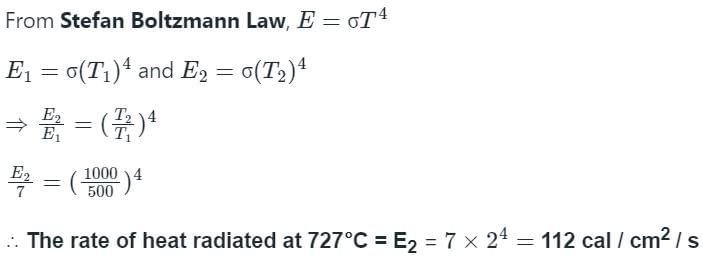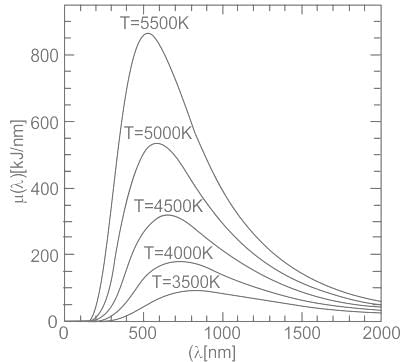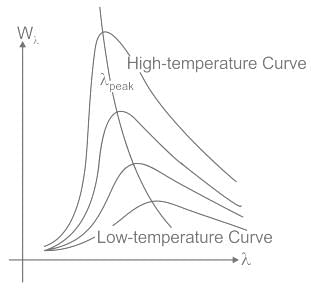All Exams >
EmSAT Achieve >
Physics for EmSAT Achieve >
All Questions
All questions of Blackbody Radiations for EmSAT Achieve Exam
The energy that will be ideally radiated by a 100 kW transmitter in 1 hour is:- a)1 × 105 J
- b)36 × 107 J
- c)36 × 104 J
- d)None of the above
Correct answer is option 'B'. Can you explain this answer?
The energy that will be ideally radiated by a 100 kW transmitter in 1 hour is:
a)
1 × 105 J
b)
36 × 107 J
c)
36 × 104 J
d)
None of the above
|
|
Huda Sameer Al Mazroui answered |
Calculation of Energy Radiated by a 100 kW Transmitter in 1 Hour:
To calculate the energy radiated by a 100 kW transmitter in 1 hour, we need to use the formula:
Energy = Power × Time
Given:
Power of the transmitter (P) = 100 kW = 100 × 10^3 W
Time (t) = 1 hour = 3600 seconds
Calculation:
Energy = Power × Time
Energy = 100 × 10^3 W × 3600 s
Energy = 100 × 10^3 W × 3600 s
Energy = 100 × 10^3 W × 3600 s
Energy = 100 × 10^3 × 3600 J
Energy = 36 × 10^7 J
Energy = 36 × 10^7 J
Energy = 36 × 10^7 J
Energy = 36 × 10^7 J
Energy = 36 × 10^7 J
Energy = 36 × 10^7 J
Energy = 36 × 10^7 J
Energy = 36 × 10^7 J
Energy = 36 × 10^7 J
Energy = 36 × 10^7 J
Therefore, the energy that will be ideally radiated by a 100 kW transmitter in 1 hour is 36 × 10^7 J, which is equivalent to 36 × 10^7 J or 36 × 10^7 J. Hence, the correct answer is option B.
To calculate the energy radiated by a 100 kW transmitter in 1 hour, we need to use the formula:
Energy = Power × Time
Given:
Power of the transmitter (P) = 100 kW = 100 × 10^3 W
Time (t) = 1 hour = 3600 seconds
Calculation:
Energy = Power × Time
Energy = 100 × 10^3 W × 3600 s
Energy = 100 × 10^3 W × 3600 s
Energy = 100 × 10^3 W × 3600 s
Energy = 100 × 10^3 × 3600 J
Energy = 36 × 10^7 J
Energy = 36 × 10^7 J
Energy = 36 × 10^7 J
Energy = 36 × 10^7 J
Energy = 36 × 10^7 J
Energy = 36 × 10^7 J
Energy = 36 × 10^7 J
Energy = 36 × 10^7 J
Energy = 36 × 10^7 J
Energy = 36 × 10^7 J
Therefore, the energy that will be ideally radiated by a 100 kW transmitter in 1 hour is 36 × 10^7 J, which is equivalent to 36 × 10^7 J or 36 × 10^7 J. Hence, the correct answer is option B.
Every object emits radiation. The radiation energy is proportional to what power of temperature?- a)T
- b)T2
- c)T3
- d)T4
Correct answer is option 'D'. Can you explain this answer?
Every object emits radiation. The radiation energy is proportional to what power of temperature?
a)
T
b)
T2
c)
T3
d)
T4

|
Arien Instructors answered |
- All objects in this world which have a temperature greater than 0 K, emit radiation.
- This radiation energy is proportional to fourth the power of Temperature (T) in Kelvin.
- Q α T4
- So, the correct answer is option 4.
A polished metal plate has a rough and black spot. It is heated to 1400 K and brought immediately in a dark room. Which of the following is true? - a)The spot will appear brighter than the plate
- b)The spot will appear darker than the plate
- c)The spot and plate will appear equally bright
- d)The spot and the plate will not be visible in the dark room
Correct answer is option 'A'. Can you explain this answer?
A polished metal plate has a rough and black spot. It is heated to 1400 K and brought immediately in a dark room. Which of the following is true?
a)
The spot will appear brighter than the plate
b)
The spot will appear darker than the plate
c)
The spot and plate will appear equally bright
d)
The spot and the plate will not be visible in the dark room

|
Arien Instructors answered |
- Since 1400 K temperature is much higher temperature compared to the room temperature. So both the polished metal plate and the rough black spot will emit radiation at a higher rate.
- Since the absorptive power of the rough black spot is more compared to the absorptive power of the polished metal plate, so according to Kirchoff's law, the emissive power of the black spot will also be more compared to the polished metal surface.
- So the rough black spot will emit more radiation compared to the polished surface.
- So the spot will appear brighter than the plate.
- Hence, option 1 is correct.
A black body at 227°C radiates heat at the rate of 7 cal / cm2 / s. At a temperature of 727°C, the rate of heat radiated in the same units will be:- a)50
- b)112
- c)80
- d)60
Correct answer is option 'B'. Can you explain this answer?
A black body at 227°C radiates heat at the rate of 7 cal / cm2 / s. At a temperature of 727°C, the rate of heat radiated in the same units will be:
a)
50
b)
112
c)
80
d)
60

|
Arien Instructors answered |
Given that:
The heat radiated at 227∘C, E1 = 7 cal / cm2 / s
Initial temperature of the body, T1 = 227∘C ⇒ (227 + 273) K = 500 K
Final temperature of the body, T2 = 727∘C ⇒ (727 + 273) K = 1000 K


A black body can absorb radiations of- a)Higher wavelength only
- b)Lower wavelengths only
- c)Intermediate wavelengths only
- d)All wavelengths
Correct answer is option 'D'. Can you explain this answer?
A black body can absorb radiations of
a)
Higher wavelength only
b)
Lower wavelengths only
c)
Intermediate wavelengths only
d)
All wavelengths

|
Arien Instructors answered |
- A black body is an idealized physical body that absorbs all incident electromagnetic radiation of any wavelengths, regardless of frequency or angle of incidence. So option 4 is correct.
The following is/are laws of black body radiation.- a)Plank’s law
- b)Stefan-Boltzmann law
- c)both of the above
- d)More than one of the above
Correct answer is option 'C'. Can you explain this answer?
The following is/are laws of black body radiation.
a)
Plank’s law
b)
Stefan-Boltzmann law
c)
both of the above
d)
More than one of the above

|
Arien Instructors answered |
The laws of blackbody radiation governed by
Planck's law of black-body radiation: Planck's law describes the spectral density of electromagnetic radiation emitted by a black body in thermal equilibrium at a given temperature T, when there is no net flow of matter and energy between the body and its environment.
Wien's displacement law: Wien's displacement law states that the blackbody radiation curve for different temperature peaks at a wavelength that is inversely proportional to the temperature.

Stefan–Boltzmann law: The Stefan–Boltzmann law describes the power radiated per unit time from a black body in terms of its temperature.

Stefan–Boltzmann law: The Stefan–Boltzmann law describes the power radiated per unit time from a black body in terms of its temperature.
"Good absorber of heat is good radiator of heat also" is- a)Stefan's law
- b)Kirchhof's law
- c)Plank's law
- d)Wien's lawa
Correct answer is option 'B'. Can you explain this answer?
"Good absorber of heat is good radiator of heat also" is
a)
Stefan's law
b)
Kirchhof's law
c)
Plank's law
d)
Wien's lawa

|
Arien Instructors answered |
- A black body is an example of a good absorber of heat as well as a good emitter of heat.
- The ease with which a black body can absorb a photon is the reverse process of emitting the one.
- This entire cycle takes place because of the number of transitions that are associated with the EM field.
Radiation with maximum penetration power is-- a)Infrared radiation
- b)Gamma rays
- c)X-rays
- d)None of the above
Correct answer is option 'B'. Can you explain this answer?
Radiation with maximum penetration power is-
a)
Infrared radiation
b)
Gamma rays
c)
X-rays
d)
None of the above

|
Arien Instructors answered |
Gamma Rays:
- A gamma ray, also known as gamma radiation.
- It is a penetrating form of electromagnetic radiation arising from the radioactive decay of atomic nuclei.
- It consists of the shortest wavelength electromagnetic waves, typically shorter than those of X-rays.
- They are produced by the hottest and most energetic objects in the universe.
Therefore, radiation with maximum penetration power is gamma rays.
As the wavelength increases , the energy emitted from the black body radiation will ............first and then............- a)Increase, become constant
- b)Increase, decreases.
- c)decrease, increases
- d)None of the above
Correct answer is option 'B'. Can you explain this answer?
As the wavelength increases , the energy emitted from the black body radiation will ............first and then............
a)
Increase, become constant
b)
Increase, decreases.
c)
decrease, increases
d)
None of the above

|
Arien Instructors answered |
The Energy Distribution curve as shown in the figure concludes that:

- As the wavelength increases, the energy emitted increases and reaches the maximum height. After this point, it started decreasing gradually.
- Hence we can say that the Energy distribution of black body radiation state that when wavelength increases, the energy emitted from the black body radiation will increase first and then decreases.
- Hence option 2 is correct.
A dark skin person compared to white skin person will experience.- a)less heat and more cold
- b)more heat and more cold
- c)low heat and low cold
- d)more heat and less cold
Correct answer is option 'B'. Can you explain this answer?
A dark skin person compared to white skin person will experience.
a)
less heat and more cold
b)
more heat and more cold
c)
low heat and low cold
d)
more heat and less cold

|
Arien Instructors answered |
- When the body will be in black colors all the light gets absorbed because black is the good absorber where white light emits or reflect all the light coming towards it.
- Application of White colors:
- Radiator in homes is painting with white.
- We wear white cloth in summer because it reflects all the light and makes our body cool.
Chapter doubts & questions for Blackbody Radiations - Physics for EmSAT Achieve 2025 is part of EmSAT Achieve exam preparation. The chapters have been prepared according to the EmSAT Achieve exam syllabus. The Chapter doubts & questions, notes, tests & MCQs are made for EmSAT Achieve 2025 Exam. Find important definitions, questions, notes, meanings, examples, exercises, MCQs and online tests here.
Chapter doubts & questions of Blackbody Radiations - Physics for EmSAT Achieve in English & Hindi are available as part of EmSAT Achieve exam.
Download more important topics, notes, lectures and mock test series for EmSAT Achieve Exam by signing up for free.
Physics for EmSAT Achieve
208 videos|329 docs|212 tests
|

Contact Support
Our team is online on weekdays between 10 AM - 7 PM
Typical reply within 3 hours
|
Free Exam Preparation
at your Fingertips!
Access Free Study Material - Test Series, Structured Courses, Free Videos & Study Notes and Prepare for Your Exam With Ease

 Join the 10M+ students on EduRev
Join the 10M+ students on EduRev
|

|
Create your account for free
OR
Forgot Password
OR
Signup to see your scores
go up within 7 days!
Access 1000+ FREE Docs, Videos and Tests
Takes less than 10 seconds to signup









